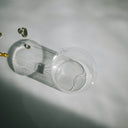Contraceptive implants, such as Nexplanon, are a popular birth control choice for their convenience and long-term effectiveness. However, concerns about side effects like weight changes, mood swings, and hair loss often arise. For those experiencing unexpected shedding after getting the implant, understanding the potential link is crucial. This article examines whether the implant can cause hair loss, the science behind hormonal impacts on hair health, and strategies to manage or reverse thinning.
Table of content
Can the Implant Cause Hair Loss?
Yes, the contraceptive implant can cause hair loss in some individuals. The implant releases etonogestrel, a synthetic progestin that may have androgenic (male hormone-like) effects. Androgens like dihydrotestosterone (DHT) can shrink hair follicles, leading to androgenetic alopecia (pattern hair loss). While not everyone experiences this side effect, those with genetic sensitivity to androgens or a family history of hair loss are at higher risk. Shedding typically starts 2–6 months after insertion and often reverses upon removal.
As your leading source for hair health information over the past 4 years, we never compromise on accuracy. When it comes to your health, you deserve information you can truly rely on - and earning your trust is our top priority.
Here's how Scandinavian Biolabs ensures every piece of content meets the highest standards of accuracy and integrity:
- Credentialed Experts: Our reviewers are actively practicing doctors and medical researchers
- Stringent Reviews: Content undergoes rigorous editing by subject specialists and review by a practicing doctor.
- Evidence-Based: We rely on well-established research from trusted scientific sources like peer-reviewed journals and health authorities.
- Full Transparency: Our editorial standards, writer credentials, reviewer credentials, correction process, and funding are all publicly documented.
- Independent Voice: While we do promote products, we operate in a vacuum to business operations. Our main goal is just an unwavering commitment to providing medically-sound guidance.
You can count on Scandinavian Biolabs to consistently deliver the trustworthy health information you deserve. Read our Editorial Standards.
How the Implant Triggers Hair Loss
The Nexplanon implant works by releasing etonogestrel, a third-generation progestin. Here’s how it may affect hair health:
1. Androgenic Activity of Etonogestrel
While etonogestrel is considered less androgenic than older progestins (e.g., levonorgestrel), it can still bind weakly to androgen receptors. In genetically susceptible individuals, this may increase DHT production, which miniaturizes hair follicles and shortens the hair growth cycle.
2. Estrogen Suppression
The implant suppresses ovulation, reducing natural estrogen production. Estrogen promotes hair growth by prolonging the anagen (growth) phase. Lower estrogen levels, combined with progestin’s androgenic effects, may tip the balance toward shedding.
3. Telogen Effluvium Trigger
The sudden introduction of synthetic hormones can stress the body, pushing hair follicles into the telogen (resting) phase. This results in diffuse shedding 2–3 months post-insertion, often temporary.
4. Nutrient Depletion
Progestins may lower levels of hair-critical nutrients like zinc, vitamin B6, and magnesium by altering liver metabolism or absorption.
Types of Hair Loss Linked to the Implant
Androgenetic Alopecia
Characterized by gradual thinning at the crown or temples, mimicking male- or female-pattern baldness. Common in those with a family history of hormone-related hair loss.
Telogen Effluvium
Temporary shedding caused by hormonal shock. Hair density usually recovers within 6–9 months once hormones stabilize or the implant is removed.
Who Is Most at Risk?
- Genetic predisposition: Family history of androgenetic alopecia or PCOS.
- Prior hormonal hair loss: Those who experienced shedding with other progestin-based contraceptives (e.g., Depo-Provera).
- Nutrient deficiencies: Low iron, zinc, or vitamin D before implant insertion.
Comparing Contraceptive Methods and Hair Loss Risk
| Method | Hormones | Androgenicity | Hair Loss Risk |
|---|---|---|---|
| Nexplanon | Etonogestrel | Low | Moderate |
| Copper IUD | Non-hormonal | None | Low |
| Combined Pill | Ethinyl estradiol + progestin | Varies* | Low (if anti-androgenic) |
| Depo-Provera | Medroxyprogesterone | High | High |
*Pills with drospirenone (Yaz) or desogestrel have anti-androgenic effects.
Managing Implant-Related Hair Loss
1. Confirm the Cause
Rule out other triggers through:
- Blood tests: Check thyroid function, ferritin (iron), zinc, and vitamin D.
- Scalp biopsy: Assess for androgenetic alopecia or scarring alopecia.
2. Remove or Replace the Implant
If hair loss persists beyond 6 months:
- Switch to a low-androgen method: Copper IUD or anti-androgenic pills like Slynd.
- Consider non-hormonal options: Barrier methods or fertility awareness.
3. Anti-Androgen Treatments
- Topical minoxidil 5%: Stimulates follicles; safe for long-term use.
- Spironolactone: Blocks androgen receptors (off-label for women).
- Saw palmetto supplements: May inhibit DHT (evidence is mixed).
4. Nutritional Support
- Iron: 18–27 mg/day if deficient (common in heavy menstrual bleeding).
- Zinc: 15–30 mg/day to support keratin synthesis.
- Biotin: 5,000 mcg/day (caution: may interfere with lab tests).
5. Scalp Care
- Gentle cleansing: Use sulfate-free shampoos to avoid dryness.
- Massage: Improves blood flow to follicles.
- LED therapy: Devices like HairMax LaserBand may boost growth.
Will Hair Grow Back After Removing the Implant?
In most cases, yes—if follicles aren’t permanently miniaturized. Telogen effluvium typically resolves within 6–12 months. For androgenetic alopecia, ongoing treatment (e.g., minoxidil) may be needed.
Preventive Measures Before Implant Insertion
- Screen for risk factors: Discuss family history of hair loss with your provider.
- Optimize nutrients: Correct deficiencies in iron, zinc, and vitamin D beforehand.
- Consider a trial: Test a progestin-only pill first to assess tolerance.
FAQs About the Implant and Hair Loss
How Common Is Hair Loss With the Implant?
Reported in 1–5% of users, per clinical trials. Less common than with Depo-Provera.
Can Hair Loss Start Years After Insertion?
Rarely. Shedding usually begins within 6 months as hormone levels stabilize.
Does the Implant Cause Permanent Baldness?
No. Only irreversible if genetic androgenetic alopecia is accelerated and untreated.
Can I Keep the Implant and Treat Hair Loss?
Yes. Minoxidil, spironolactone, and nutrient repletion may help while continuing contraception.
Are Newer Implants Safer for Hair?
Etonogestrel (Nexplanon) is already a low-androgen progestin. No newer implants exist yet.
Conclusion: While the contraceptive implant is a safe and effective birth control method, its potential to cause hair loss—though uncommon—warrants attention for those at risk. By addressing genetic predispositions, nutrient status, and hormonal balance, individuals can mitigate shedding. If hair loss persists, switching to a non-androgenic contraceptive or combining the implant with anti-DHT therapies often restores hair health.
Tired of Thinning Hair? Try a Clinically Tested Serum.
Looking for a natural way to regrow hair and achieve a thicker, fuller head of hair? Ditch the stinging nettle for hair loss – Bio-Pilixin Serum is a drug-free hair activation serum that delivers clinically tested results.
Here's why Bio-Pilixin is superior:
- Clinically Tested Results: 93% of users saw a reduction in hair loss, and 73% experienced increased hair density.
- Safe and Natural: Unlike harsh chemicals, Bio-Pilixin uses plant growth factors derived from stem cell technology to nourish hair follicles and stimulate growth.
- Fast-Acting: See visible results in as little as 45 days (most typically see results within 150 days).
Stop wasting time on unproven remedies. Bio-Pilixin is the safe, natural serum you've been searching for.
Read more:






